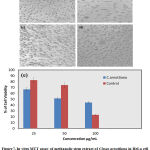P. Selvi 1 , S. Murugesh 1*
, S. Murugesh 1* ,, R. Yuvarajan2 and A. Rajasekar3
,, R. Yuvarajan2 and A. Rajasekar3
1Department of Botany, School of Life Sciences, Periyar University, Salem, Tamil Nadu, India
2Department of Biotechnology, Mahendra Arts and Science College, Kalippatti, Namakkal, Tamil Nadu, India.
3Department of Biotechnology, SRM Institute of Science and Technology, Ramapuram Campus, Chennai, India.
Corresponding Author E-mail: murugshss@rediffmail.com
DOI : https://dx.doi.org/10.13005/bpj/2243
Abstract
Modern lifestyle, pollution, food habit, and stress have intensively enhanced the evolution of several diseases on human being. Medicinal plants are used from the ancient times for the therapeutic needs to cure various diseases as well as less toxic in nature. One of such plant is Cissus arnottiana which is used from the olden days which has been identified as an important medicine plant by many researchers all over the world. Cissus arnottiana contains phytochemicals such as alkaloids, tannins, terpenoids, flavonoids, phenolic compounds etc. In this present work methanolic stem extract of Cissus arnottiana is used to evaluate the antibacterial activity of gram negative and gram positive human pathogenic bacteria. DPPH assay is used to investigate the antioxidant properties of the methanolic extract. The anti-inflammatory activity of the extract has been studied using anti proteinase assay. The MTT cell proliferation assay is carried out against HeLa cell line in which 44% of cells are viable for the concentration of 100 µg/mL. Interestingly, the methanolic stem extract can be used as a potential candidate for new therapeutic applications.
Keywords
Cissus arnottiana; Cell Lines; Plants Extract; Phytochemicals
Download this article as:| Copy the following to cite this article: Selvi P, Murugesh S, Yuvarajan R, Rajasekar A. Screening the Therapeutic Potential of Methanolic Stem Extract of Cissus arnottiana. Biomed Pharmacol J 2021;14(3). |
| Copy the following to cite this URL: Selvi P, Murugesh S, Yuvarajan R, Rajasekar A. Screening the Therapeutic Potential of Methanolic Stem Extract of Cissus arnottiana. Biomed Pharmacol J 2021;14(3). Available from: https://bit.ly/3kRe2ER |
Introduction
From the ancient traditional time, medicinal plants had played a vital role in medication field. The best antidote for curing various diseases is done using plant kingdom 1,2. Interestingly, it is found that three quarters of world population depends on plant extracts for most of the healthcare issues 3. According to WHO, it is reported in the recent years 80% of world population uses traditional medicinal plant extract for health coverage. Interestingly it is found that due to the nuisance in using drugs and its side effects 38% of Americans uses traditional plant extracts for medicinal issues 4. When compared with the allopathic medicine, plant and its extracts give better relief due to the discomfort caused by the synthetic drugs. The pharmaceutical industries that discover drugs also depend on the natural plant and its extract equally due to its aftermath caused by the drugs used in the medicines, which leads to ample loss in the field of pharmaceutical 2. Therefore, plants and its extracts-based ealth care products is trending in both developed and developing countries. By using herbal plants for the treatment such as allergic, cardiovascular diseases, diabetes and metabolic diseases will alleviate that by using the drugs that causes side effects 2,3. In comparison with other countries, India is said to have thousands of natural herbal plants, were different parts such as leaves, stem, roots, fruit, seed and bark of the herbal plant is used to cure specific aliments us been vogue1,5,6. Globally, due to the over population, continuous exploitation of herbal plants, urbanization, traditional knowledge about the natural herbals are getting depleting day by day 2,6.
In recent years, the medicinal plants have attracted many researchers with its potential antioxidant properties, which had received significant attention for an enhanced alarm for safe and non-toxic 1,7. Phytochemicals are defined as medicinal value of plant which activates the chemical compounds to produce the physiological action on the human being. It can be classified into two groups such as primary and secondary constituents according to the plant metabolism. Primary constituents consist of amino acids, common sugar, proteinnd chlorophyll while the secondary constituents consist of alkaloids, tannins, terpenoids, flavonoids, phenolic compounds etc 1,8. In recent years, many researchers are encouraged in scientific authentication and explanation for the activity of the herbal plants, which are used as medicine around the world 7. One such plant that is used in all continents and implemented to treat different aliments is the plant belonging to the genus “Cissus” among various plants evaluated in the therapeutic efficacies 4. Cissus arottiana commonly known as “Nanaminukki” in tamil and “Nelagummadi” in telugu. This Cissus arottiana belongs to Vitaceae family. Cissus arottiana is an erect woody shrub with bruised root. Medicinal benefits of the bruised roots for diseases such as rheumatic swellings possess antibacterial, antioxidant, anti-inflammatory, and anti-viral activity are reported earlier 9,10. Phytochemical screening of Cissus arottiana is found that most of the biologically active phytochemicals are present in the ethanolic extract of leaves and fruits extract contain alkanoids, flavonoids phenols, tannins, terpenoids, quinies, saponins, glycosides, and carbohydrates.
In the present investigation, we evaluate the antimicrobial, antioxidant, anti-inflammatory, and anticancer activity of Cissus arnottiana stem extract. To the best of our knowledge, no studies have been reported, for the investigation of the antimicrobial properties against a selection of gram-positive and gram-negative pathogenic bacteria. The study also evaluates antioxidant activity based on DPPH assay, anti-inflammatory, and anticancer properties of the methanolic stem extract of Cissus arnottiana.
Materials and Methods
Collection and preparation of plant materials
The stems of Cissus arnottiana were freshly collected from Kanjamalai hills, Salem district, Tamil Nadu, India in the month of March 2016. The plant specimen was identified as authenticated by Botanical survey of India [ref no: BSI/SRC/23/2016/Tech/1071], Coimbatore, India. The stem samples were cleaned thoroughly using air dried technique to remove soil and unwanted particles attached to it. The stems were immediately washed with double distilled water, cut into pieces, and dried under shade conditions. The dried stem was grounded into fine particles using a blender and stored in an air-tight container for further use.
Extraction of Cissus arnottiana
10g of finely grounded stem powder were independently macerated in 100 mL of methanol for 24 hrs. The above soaked solution was filtered using Whatmann filter paper (No. 1). The filtered methanol solution is transferred to micro tubes and stored in the refrigerator at 4°C until for further use 11.
Characterization Techniques
UV-Visible spectroscopic analyses were carried out to confirm the presences of phytochemicals in the extract. The absorbance spectra were recorded using UV-Visible spectrophotometer (T-90 UV-Visible Spectrophotometer, PG instruments, Lab India Pvt). Fourier Transform Infrared spectroscopy (FTIR) carried out to identify the active functional groups present in the stem extract. IR spectrum is obtained using Bruker 1 FS 66U. FTIR operated under transmission mode with wavelength from 400-4000 cm-1 at a resolution of 4 cm-1.
Antibacterial Activity
In this study, six different human pathogenic bacteria (3 gram positive, 3 gram negative) Bacillus subtilis, Staphylococcus aureus, Bacillus cerus, Klebsiella planticola, Escherichia coli and Klebsiella pneumonia. The antimicrobial activity of the plant extract was performed using well diffusion assay. The methanol (1mg/mL) is used as a control. The wells of 6mm were impregnated with serial concentration of methanolic stem extract (20, 40, 60 and 80 µL). After inoculation, the plates were incubated at 37°C for 24 hrs and the zone of inhibition (ZOI) around the well was measured 12,13. The ZOI was measured in mm and the assays were repeated for triplicate.
Antioxidant Activity
The antioxidant activity of the methanolic stem extract of Cissus arnottiana against DPPH substrate was performed by the method reported by Gunjan Guha et. al 14. A stem extract of (20, 40, 60, 80 and 100 µL) were added with 1 mL of DPPH solution and the mixture is mixed well. The mixture was kept for 40 mins at 20°C in a dark condition 9,15. The absorbance is measured at 517nm using UV-Visible spectrophotometer. All analyses were carried out I triplicate and average values were reported.
In-Vitro anti-inflammatory activity by anti-proteinase action
The anti-inflammatory activity was performed according to the modified method by Oyedepo et al 16 and sakat et al 17. The mixture of 2 mL consists of 0.06 mg trypsin, 1 mL 20mM Tris HCl buffer (pH=7.4) and 1 mL of stem extract with different concentration (50), 100 and 150 µg/mL). The above mixture was incubated at 37°C for 5 mins and 1 ml of 0.8% (W/N) casein was added again the mixture was incubated for 20 mins additionally. Then, 2 mL of 70% per chloric acid was added to stop the reaction. The above cloudy suspension was centrifuged and then absorbance is measured at 660 nm against buffer as blank 18. The experiment was performed in triplicate.
Anticancer Activity
Cancer cell proliferation test was carried out against methanolic stem extract of Cissus arnottiana using MTT assay. HeLa cells were cultured in 96 well plates with a density of 2.4×104 per well and incubated at 37°C for 24 hrs. The 100 µL of methanolic stem extract were added in each well with different concentrations (20, 50 and 100 µg/mL) were incubated at a temperature 37°C for 48 hrs. After incubation, medium was discarded ad a new medium of 150 µL containing 0.5mg/mL MTT solution concentrated in DMEM were added to each well. Then, the plates were incubated at 37°C for 4 hrs until a formazan crystal is formed. Using an inverted microscope, the cells were imaged. Absorbance of the MTT assay is measured at 560 nm using UV-Visible spectrophotometer 19. The well without the cells is used as the control. The effect of the methanolic stem extract on the HeLa cells was expressed as % cell viability, using the formula,
Statistical Analysis
All experiments were done in triplicate. The results were expressed as mean ± Standard deviation. P < 0.05 is considered statistically significant for all analysis.
Result and Discussion
Figure 1, shows the UV-Visible spectra of the methanolic stem extract of Cissus arnottiana typically consist of a broad absorption maxima in the range of 230-260 nm and 290-360 nm. The UV-Visible spectra confirm the presence of phytochemicals such as alkanoids, phenols, flavonoids, steroids and tannins in the extract 20. The precise position and relative absorbance of these maxima give useful information on the nature of the phytochemicals present in the extract.
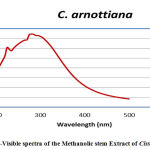 |
Figure 1: UV-Visible spectra of the Methanolic stem Extract of Cissus arnottiana. |
Figure 2, shows the FTIR spectrum is used to identify the functional group of the active components present in the extract. By interpreting the IR absorption spectrum, the chemical bonds present in the compound can be determined. The FTIR spectra of Cissus arnottiana wave peaks characteristic phenyl group, aromatic group, hydroxyl aromatic group, carboxylic and alkane group in the extract 21. The peak at frequency of 3260, 1603, 1316, 1033 and 779 cm-1 were strong peaks as shown in the figure 2.
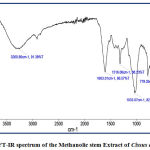 |
Figure 2: FT-IR spectrum of the Methanolic stem Extract of Cissus arnottiana. |
The methanolic stem extract of Cissus arnottiana shows an excellent antibacterial activity against human pathogenic gram positive and gram negative bacteria. The antimicrobial assay were performed against k planticola, E coli and k pneumonia gram negative bacteria with different concentration of methanolic stem extract (20, 40, 60 and 80 µL) using well diffusion method. Figure 3, clearly shows that the ZOI increases as the concentration of the methanolic stem extract increases against the gram negative bacteria, whereas the ZOI of the control is very less compared with the extract. K. planticola shows a higher activity against the methanolic stem extract which is 13.20 mm at 80 µL. interestingly E. coli and K. pneumonia also exhibits a excellent activity with a ZOI of 12.11 and 11.65 mm at 80 µL which is comparably lesser than K. planticola 12,13.
Comparing the ZOI, gram positive bacteria also exhibits antimicrobial activity. S. aureus shows a good activity against methanolic stem extract which is 12.37 mm at 80 µL. B. subtilis and B. cerus also exhibits antimicrobial activity with a ZOI of 10.27 and 7.85 mm at 80 µL respectively. Overall, from the antimicrobial activity of gram negative bacteria is higher compared with gram positive bacteria. Notably, in gram negative bacteria the thickness of the peptidoglycan layer is less compared with the gram positive bacteria, where the major function of this layer is to protect the cells against antibacterial agents such as antibiotics, chemicals, enzymes and toxins 11,22. Thus, from the results it is reveals that the methanolic stem extract shows a maximum antimicrobial activity against the gram negative bacteria than the gram positive bacteria (Table 1).
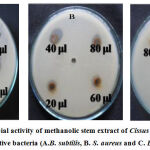 |
Figure 3: Antimicrobial activity of methanolic stem extract of Cissus arnottiana against gram positive bacteria (A.B. subtilis, B. S. aureus and C. B. cerus) |
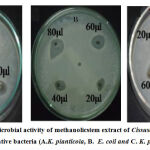 |
Figure 4: Antimicrobial activity of methanolicstem extract of Cissusarnottiana against gram negative bacteria (A.K. planticola, B. E. coli and C. K. pneumoniae) |
Table 1: Antibacterial activity of methanolicstem extract of Cissus arnottiana against pathogenic bacteria. ZOI was measured as millimeter ± standard deviation for three independent experiments.
| Bacterial Isolates | Zone of Inhibition (mm) | |||
| 20 µl | 40 µl | 60 µl | 80 µl | |
| Bacillus subtilis | 6.13±0.07 | 7.17±0.12 | 9.33±0.20 | 10.27±0.15 |
| Staphylococcus aureus | 6.17±0.09 | 7.45±0.18 | 9.13±0.09 | 12.37±0.19 |
| Bacillus cerus | 6.00±0.00 | 6.13±0.13 | 7.1±0.15 | 7.85±0.11 |
| Klebsiella planticola | 6.22±0.07 | 8.18±0.21 | 10.33±0.88 | 13.20±0.21 |
| Escherichia coli | 6.32±0.09 | 8.33±0.21 | 10.13±0.12 | 12.71±0.24 |
| Klebsiella pneumoniae | 7.52±0.21 | 7.93±0.13 | 9.1±0.21 | 11.65±0.98 |
The DPPH assay is used to measure the free radical scavengers or hydrogen donor present in the methanolic stem extract. The antioxidant activity of the extract was evaluated using DPPH assay is shown in the figure 5. The oxidant inhibition of the molecules by inhibiting the oxidative chain reaction and formation of non-reactive radicals is known as antioxidant activity. It is reported that the extract have a tendency to scavenge free radicals by either accepting or donating electrons based on the reaction, which results in the change of color from purple to yellow colored hydrazine molecule. Figure 5, shows the effect of the methanolic stem extract with different concentration of DPPH assay. The concentration of extract increases, with increase in the DPPH scavenging activity. From the figure 5, shows a strong radical scavenging potential of the methanolic stem extract. The increase in the scavenging potential of the extract is due to the phytochemicals present in the Cissus arnottiana. Therefore, the phytochemicals present in the methanolic stem extract is solely responsible for the enhancement of free radical scavenging activity 9,15. Additionally, the presence of phytochemicals such as polyphenols and flavonoids were confirmed from the FT-IR and UV-Visible studies. These phytochemicals are well known to possess persuasive antioxidant activity, which protects the ells against free radicals from oxidative stress.
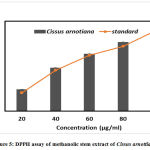 |
Figure 5: DPPH assay of methanolic stem extract of Cissus arnottiana. |
Figure 6, shows the antiproteinase activity of the methanolic stem extract of Cissus arnottiana. The maximum antiproteinase inhibition was observed at 150 µg/mL which exhibits 64%, followed by the 100 and 50 µg/mL. The concentration of the methanolic stem extract of Cissus arnottiana increases as the anti-inflammatory activity also increases. The methanolic stem extract of Cissus arnottiana shows an excellent anti-inflammatory activity at higher concentration of the extract 18,23.
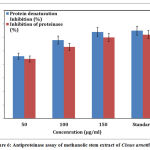 |
Figure 6: Antiproteinase assay of methanolic stem extract of Cissus arnottiana |
Anticancer activity of the methanolic stem extract was evaluated using an MTT in-vitro cell proliferation assay is shown in the figure 7. Based on the MTT assay the absorbance decreases with the increase in the concentration of the extract. The concentration of 100 µg/mL of the extract was found to be 44.28% of cells are viable. Therefore, it can be concluded that Cissus arnottiana can be used as a potential anticancer agent. Thus, the anticancer activity is mainly due to the phytochemicals present in the stem of the Cissus arnottiana 11,19,24. Then methanolic stem extract has decreases the percent of viability of HeLa cells. Figure 8, shows the microscopic images which reveal the morphological changes and shrinkage of the cells leading to the cell death induced by the extract.
Conclusions
The present study suggestthat the methanolic stem extract of Cissus arnottiana shows an excellent antimicrobial activity against gram negative bacteria compared with gram positive bacteria. Based on the results of antioxidant, anti-inflammatory using anti proteinase assay and anti-cell proliferation shows an excellent activity at a concentration of 100 µg/mL of the extract was found to be 44.28% of cells are viable against the methanolic stem extract of Cissus arnottiana. Additionally, it is observed that Cissus arnottiana constituents a wide variety of secondary metabolites that holds strong biological activity based on the experiments performed in this work. Thus, the methanolic stem extract can be used as a potential candidate for new therapeutic option as an anticancer drug. Therefore, it overlays to further research to identify the active phytochemicals responsible for the biological activity and its mechanism must studied further.
References
- Kavitha, S., and Rajeshwari, S. Pharmacognostical and Phytochemical Screening of Fruit and Leaves of Cissus Arnottiana. Asian Journal of Pharmaceutical and Clinical Research; 5(2): 64-66 (2012).
- Monokesh Kumer sen, and Biplab Kumar Dash. A review on phytochemical and pharmacological aspects of Cissus quadrangularis L. International Journal of Green Pharmacy; 6: 169-173 (2012)
CrossRef - Yaro, AH., Anuka, J., Salawu, O., Hussaini, IM., Usman, H., and Musa, AM. Comparative Neuropharmacological Activities Methanolic Extracts of Leaves and Roots of Cissus Cornifolia in Mice. African Journal of Biomedical Research; 12(3): 219-223 (2009)
- Gabriel Fernandes and Jameela Banu. Medicinal properties of plants from the genus Cissus: A review. Journal of Medicinal Plants Research; 6(16): 3080-3086 (2012)
CrossRef - Sidney, JS., and Sidhartha, DR. A review and evaluation of the efficacy and safety of Cissus quadrangularis extracts. Phytotherapy Research; DOI: 10.1002/ptr.4846, (2012)
CrossRef - Yaro, AH., Musa, AM., Nazifi, AB., and Magaji, MG. Butanol soluble fractions of Cissus cornifolia methanolic leaf extract and behavioural effects in mice. The Journal of Phytopharmacology; 4(4): 202-206 (2015)
CrossRef - Talent, C., Ibrahim, MA., Koorbanally, NA., and Islam, MS. In Vitro Antioxidant Activity and GC-MS Analysis of the Ethanol and Aqueous Extracts of Cissus Cornifolia (Baker) Splanch (Vitaceae) Parts. Acta Poloniae Pharmaceutica and Drug Research; 72(1): 119-127 (2015)
CrossRef - Ansarali, S., Manikandan, S., and Lakshmanan, GG. Review on Phytochemical and Pharmacological activities of the genus Cissus Linn. International Journal of Pharmaceutical Research; 8(4): 1-7 (2016)
CrossRef - Manjamadha, VP., and Muthukumar, K. Ultrasound assisted green synthesis of silver nanoparticles using weed plant. Bioprocess Biosyst Eng; 39: 401-411 (2016)
CrossRef - Walli, RR., Al-Musrati, RA., Eshtewi, HM., and Sherif, FM. Screening of Antimicrobial Activity of Fenugreek Seeds. Pharmacy & Pharmacology International Journal; 2(4): 1-4 (2015)
CrossRef - Senthil, B., Devasena, T., Prakash, B., and Rajasekar, A. Non-cytotoxic effect of green synthesized silver nanoparticles and its antibacterial activity. Journal of Photochemistry & Photobiology, B: Biology; 177: 1–7 (2017)
CrossRef - Alwhibi, MS., and Soliman, DA. Evaluating the Antibacterial Activity of Fenugreek (Trigonella foenum-graecum) Seed Extract against A Selection of Different Pathogenic Bacteria. Journal Of Pure & Applied Microbiology; 8(2): 817-821 (2014)
- Sharma, V., Singh, P., and Rani, A. Antimicrobial Activity of Trigonella foenum-graecum (Fenugreek). European Journal of Experimental Biology; 7(14): 1-4 (2017)
- Guha, G., Rajkumar, V., Ashok Kumar, R., and Mathew, L. Aqueous extract of Phyllanthus amarus inhibits chromium (VI)—induced toxicity in MDA-MB-435S cells. Food Chem Toxicol; 48; 396–401 (2010)
CrossRef - Akbari, S., Abdurahman, NH., Yunus, RM., Alara, OR., and Abayomi, OO. Extraction, Characteristic and Antioxidant activity of Fenugreek (Trigonella foenum-graecum) seed oil. Materials Science for Energy Technologies; 2: 349-355 (2019)
CrossRef - Oyedepo, OO., and Femurewa, AJ. Anti‐protease and membrane stabilizing activities of extracts of Fagra zanthoxiloides, Olax subscorpioides and Tetrapleura tetraptera. Int J of Pharmacong; 33: 65‐69 (1995)
CrossRef - Sakat, S., Juvekar, AR., and Gambhire, MN. In vitro antioxidant and anti-inflammatory activity of methanol extract of Oxalis corniculata Linn. International Journal of Pharma and Pharmacological Sciences; 2(1): 146-155 (2010)
- Leelaprakash, G., and S.Mohan Dass, S. In Vitro Anti-Inflammatory Activity of Methanol Extract of Enicostemma Axillare. International Journal of Drug Development & Research; 3(3): 189-196 (2011)
- Igarashi, M., and Miyazawa, T. The growth inhibitory effect of conjugated linoleic acid on a human hepatoma cell line, HepG2, is induced by a change in fatty acid metabolism, but not the facilitation of lipid peroxidation in the cells. Biochim Biophys Acta; 1530: 162–71 (2001)
CrossRef - Rajeshkumar, R., and Jeyaprakash, K. Screening of UV-VIS, TLC and FTIR spectroscopic studies on selected red seaweed (Acanthophora specifera) collected from Gulf of Mannar, Tamilnadu, India. World Journal of Pharmaceutical Sciences; 4(10): 28-33 (2016)
- Bhuvaneswari, S., Radhika, K., and Sundarapandian, S. Preliminary phytochemical screening and spectroscopic analysis of Ormocarpum sennoides DC. International Journal of Research Pharmaceutical Sciences; 5(3): 216-220 (2014)
- Balakumaran, MD., Ramachandran, R., Balashanmugam, P., Mukeshkumar, DJ., and Kalaichelvan, PT. Mycosynthesis of silver and gold nanoparticles: optimization, characterization, and antimicrobial activity against human pathogens, Res; 182: 8–20 (2015)
CrossRef - Naz, R., Ayub, H., Nawaz, S., Islam, ZU., Yasmin, T., Bano, A., Wakeel, A., Zia, S., and Roberts, TH. Antimicrobial activity, toxicity, and antiinflammatory potential of methanolic extracts of four ethnomedicinal plant species from Punjab, Pakistan. BMC Complementary and Alternative Medicine; 17: 302 (2017)
CrossRef - Purnamasari, R., Winarni, D., Permanasari, AA., Agustina, E., Hayaza, S., and Darmanto, W. Anticancer Activity of Methanol Extract of Ficus carica Leaves and Fruits Against Proliferation, Apoptosis, and Necrosis in Huh7it Cells. Cancer Informatics; 18: 1-7 (2019)
CrossRef








